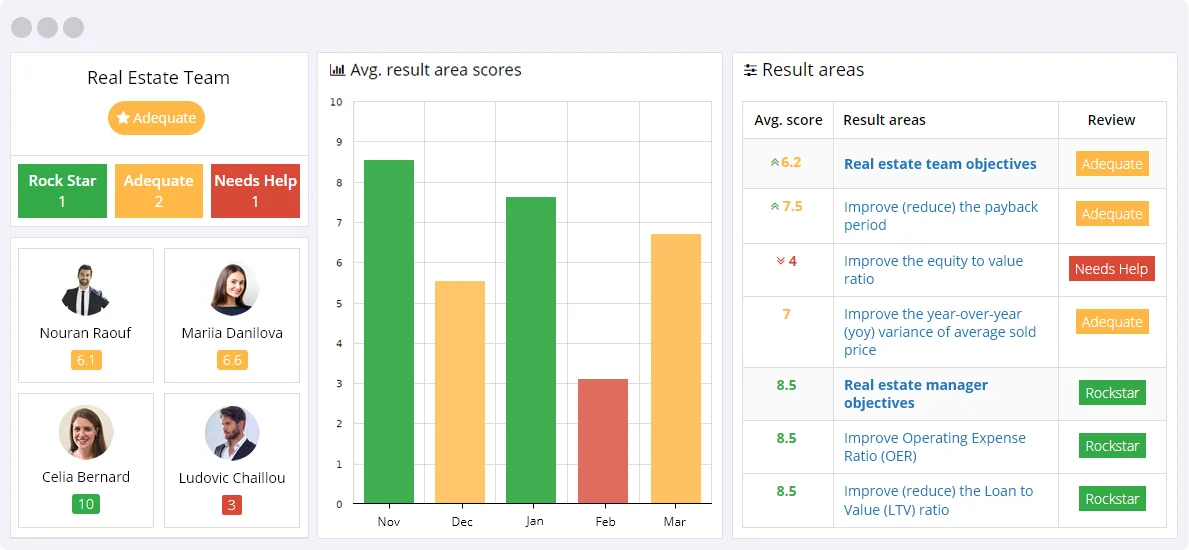Business
KPIs and Metrics for Evaluating Your Home Sales Team

Key Takeaways:
• Understanding key performance indicators (KPIs) and their significance.
• Evaluating individual and team performance through specific metrics.
• Strategies to boost your home sales team’s productivity.
For home sales managers, gauging the effectiveness of your team is crucial to ensuring consistent sales growth and achieving business objectives. Using a robust set of key performance indicators (KPIs) can help you measure what matters most. Organizations like New Home Star frequently leverage KPIs to maintain high-performing sales teams. By focusing on the right metrics, you can foster a culture of continuous improvement and accountability within your team.
Why Are KPIs Important?
KPIs are essential for providing actionable insights into your sales operations. These indicators help identify strengths and weaknesses, offering a clear picture of where strategic adjustments are needed for better performance. Without these metrics, assessing your sales team’s effectiveness becomes a guessing game, leading to missed opportunities and inefficiencies.
Top KPIs for Home Sales Teams
Sales Volume
One of the most straightforward KPIs is sales volume, which measures the number of homes sold within a given period. Tracking this metric helps gauge the overall productivity of your team and assess market demand.
Conversion Rate
Conversion rate indicates the percentage of leads that result in successful sales. A high conversion rate signifies that your team is effectively closing deals, while a low rate may indicate the need for better sales training or process improvements. According to a study by Statista, the average conversion rate in real estate hovers around 1.47%, which can serve as a benchmark.
Average Selling Price
This metric offers insights into the profitability of your transactions. By tracking the average selling price, you can further understand your market segments and tailor your marketing strategies to maximize revenue.
Customer Satisfaction
Content customers frequently bring in new business and recommendations. By using surveys and comments to gauge client happiness, you may find areas for development and adopt a more customer-centric strategy. Resources like Forbes explain how important it is to use client feedback to improve sales tactics.
Strategies to Improve KPI Performance
Continuous Training and Development
Investing in ongoing training initiatives can significantly improve your sales team’s performance. Regular workshops and seminars can provide them with the tools and knowledge they need to excel.
Leveraging Technology
Utilize CRM software and analytics tools to streamline your sales processes. These technologies can offer real-time insights, automate routine tasks, and free up your team to focus on closing deals.
Individual Performance Reviews
Conducting regular reviews of individual performance can provide personalized feedback and recognize achievements. This tailored approach encourages a sense of ownership and motivates team members to perform at their best.
Setting Realistic Goals
Establish attainable, well-defined goals for your group. Reasonable goals guarantee that everyone agrees with the company’s aims and help sustain morale. In this sense, the idea of SMART goals—specific, Measurable, Achievable, Relevant, and Time—bound—is very useful.
Conclusion
Including KPIs and metrics in your review process is an organized way to evaluate the effectiveness of your home sales team. These tools can help you find areas for development and implement successful tactics. By utilizing contemporary technology, encouraging ongoing improvement, and maintaining a laser-like focus on important KPIs, you can ensure that your team not only achieves but surpasses its sales targets. An organized way to evaluate the effectiveness of your home sales team is to include KPIs and metrics in your review process. You may find areas for development and put successful tactics into practice by using these tools. You can make sure your team not only achieves but surpasses its sales targets by utilizing contemporary technology, encouraging ongoing improvement, and maintaining a laser-like focus on important KPIs.
Business
What is the best way to find a kraft paper bag supplier

When it comes to choosing the right packaging for your products or gifts, kraft paper bags have become increasingly popular due to their eco-friendliness and versatility. However, finding a reliable kraft paper bag supplier can be a daunting task, especially with so many options available. In this guide, we’ll explore the best ways to find a kraft paper bag supplier that meets your needs and ensures you get high-quality products.
Why Choose Kraft Paper Bags?
Before diving into the search for a supplier, let’s briefly discuss why kraft paper bags are a great choice:
- Eco-Friendly: Kraft paper is biodegradable and recyclable, making it an environmentally conscious choice.
- Durable: These bags are known for their strength and ability to carry heavier items.
- Customizable: Kraft paper bags can be easily customized with prints, logos, and designs, adding a personal touch to your packaging.
1. Define Your Requirements
The first step in finding a suitable kraft paper bag supplier is to clearly define your requirements. Consider the following factors:
- Bag Size and Type: Determine the size and type of kraft paper bag you need, whether it’s for groceries, retail, or gift packaging.
- Customization: Decide if you need custom printing, embossing, or special finishes.
- Quantity: Estimate the quantity you’ll need, as this can affect the supplier’s pricing and minimum order requirements.
- Budget: Set a budget to help narrow down your options.
2. Research Online Suppliers
The internet is a valuable resource for finding kraft paper bag suppliers. Here’s how you can leverage online platforms:
- Search Engines: Use search engines like Google to find kraft paper bag suppliers by typing keywords such as “kraft paper bag supplier” or “custom kraft paper bag.” This will give you a list of potential suppliers with their websites and contact information.
- Industry Directories: Websites like ThomasNet and Alibaba have directories of packaging suppliers, including those specializing in kraft paper bags. These platforms often provide supplier reviews, company profiles, and contact details.
- Social Media: Platforms like LinkedIn and Instagram can also help you find suppliers. Many businesses use social media to showcase their products and connect with potential clients.
3. Evaluate Supplier Credentials
Once you have a list of potential suppliers, it’s essential to evaluate their credentials to ensure they meet your standards:
- Company Reputation: Research the supplier’s reputation by reading reviews and testimonials from other customers. Look for feedback on product quality, reliability, and customer service.
- Certifications and Standards: Check if the supplier complies with industry standards and certifications, such as ISO or FSC (Forest Stewardship Council) certification, which indicates sustainable practices.
- Experience: Consider the supplier’s experience in the industry. Established suppliers with a track record of delivering quality products are often more reliable.
4. Request Samples
Before placing a large order, request samples from the suppliers you’re considering. This allows you to:
- Assess Quality: Evaluate the quality of the kraft paper, printing, and overall construction of the bags.
- Check Customization: Ensure that any custom designs or prints meet your expectations.
- Compare Options: Compare samples from different suppliers to make an informed decision.
5. Consider Customer Service and Communication
Effective communication and good customer service are crucial for a smooth working relationship. Consider the following:
- Responsiveness: Evaluate how quickly and effectively the supplier responds to your inquiries.
- Support: Ensure they provide support throughout the ordering process, including addressing any issues or concerns.
- Flexibility: Check if they can accommodate special requests or changes to your order.
6. Compare Pricing and Terms
Pricing is a significant factor when choosing a supplier, but it’s essential to consider the overall value rather than just the cost:
- Pricing Structure: Compare pricing across different suppliers and understand what’s included in the cost (e.g., shipping, customization fees).
- Minimum Order Quantities: Some suppliers have minimum order requirements, so ensure they align with your needs.
- Payment Terms: Review the payment terms and conditions, including any deposits or payment schedules.
7. Build a Relationship
Establishing a good relationship with your kraft paper bag supplier can be beneficial for long-term success:
- Regular Orders: Consider placing regular orders to build a strong business relationship and potentially secure better pricing or terms.
- Feedback: Provide feedback on their products and services to help them improve and better meet your needs.
Conclusion
Finding the right kraft paper bag supplier involves careful research and consideration. By defining your requirements, researching online, evaluating suppliers, requesting samples, and comparing pricing, you can make an informed decision. A reliable supplier will provide high-quality products, excellent customer service, and a smooth ordering experience. Embrace the eco-friendly and customizable benefits of kraft paper bags, and you’ll be on your way to finding the perfect supplier for your packaging needs.
Business
Social media is a powerful tool for small business owners

In today’s digital age, social media is a powerful tool for small business owners looking to connect with their audience, build brand awareness, and drive sales. Maximising social media engagement as a small business owner requires a thoughtful and proactive approach. You don’t have as many resources as bigger companies, so you’ll have to be creative.
Whether you’re a startup trying to get your foot in the door with new clients, or a novice dog breeder trying to sell your pets online, you can leverage social media to your advantage. There are several core principles that should serve you well when trying to build your social media presence.
Identify Your Target Audience
Define your target demographic by analysing customer data and social media analytics. Understanding who your audience is will help you tailor your content and engagement strategies to their preferences, interests, and online behaviours.
Create Buyer Personas
Develop detailed buyer personas to better understand your audience’s needs and preferences. These personas should include demographic information, interests, and common pain points your customers face. Tailoring your content to these personas will make your messages more relevant and impactful.
Visual Appeal
Invest in high-quality visuals, including images, videos, and graphics, to capture attention and convey your brand’s message effectively. Visual content is more likely to be shared and can significantly increase engagement on your posts.
Content Variety
Diversify your content with a mix of posts. Include educational articles, behind-the-scenes glimpses, customer testimonials, and interactive polls. Variety keeps your audience interested and engaged.
Storytelling
Use storytelling to make your content relatable and memorable. Share your brand’s journey, values, and customer success stories. People connect with stories on an emotional level, which can help build a loyal following.
Regular Posting Schedule
Maintain a consistent posting schedule to keep your audience engaged and informed. Use social media management tools to plan and schedule posts in advance, ensuring a steady stream of content.
Respond Promptly
Monitor your social media channels and respond to comments, messages, and reviews promptly. Show appreciation for positive feedback and address concerns professionally. Prompt responses show that you value your audience’s input and are committed to providing excellent service.
Engage with Your Community
Participate in conversations, join relevant groups, and engage with other brands and influencers in your industry. Active participation can help you build a network and increase your visibility.
Effective Use of Hashtags
Research and use relevant hashtags to increase the visibility of your posts. Hashtags help categorise your content, making it easier for users interested in those topics to find you. Create unique branded hashtags to encourage user-generated content and build a community around your brand.
Stay Current with Trends
Keep an eye on trending topics and incorporate them into your content when relevant. Participate in popular challenges and social media trends to increase engagement. Aligning your content with current trends can boost visibility and relevance.
Leverage Social Media Features
Stories and Reels
Utilise features like Stories and Reels on platforms like Instagram and Facebook to share ephemeral content and engage with your audience in real-time. These features are perfect for sharing behind-the-scenes content, quick updates, and engaging with followers through interactive elements like polls and questions.
Live Streaming
Host live sessions to connect with your audience, answer questions, and showcase new products or services. Live streaming adds a personal touch to your interactions and allows for real-time engagement, which can strengthen the relationship between your brand and your audience.
Polls and Quizzes
Create interactive content such as polls, quizzes, and surveys to encourage audience participation and gather valuable insights. Interactive content not only engages your audience but also provides you with feedback that can inform your marketing strategies.
Track Performance
Use social media analytics tools to track the performance of your posts, identify what works, and understand your audience’s engagement patterns. Regular analysis helps you stay informed about your social media effectiveness and make data-driven decisions.
Adjust Strategies
Based on your analytics, refine your content strategy, posting times, and engagement tactics to maximise results. Flexibility is key to adapting to changing trends and audience preferences.
A/B Testing
Conduct A/B testing with different types of content, headlines, and images to determine what resonates best with your audience. Testing allows you to optimise your content for maximum engagement and effectiveness.
Influencer Partnerships
Collaborate with influencers in your industry to reach a wider audience and enhance credibility. Influencers can introduce your brand to their followers, providing an authentic endorsement that can drive engagement and increase your reach.
User-Generated Content
Encourage your customers to create and share content featuring your products or services. Highlight and reward the best contributions. User-generated content not only provides authentic testimonials but also fosters a sense of community and loyalty among your customers.
Conclusion
By understanding your audience, creating high-quality content, engaging consistently, and leveraging social media features, you can build a strong online presence and foster meaningful connections with your audience. Stay motivated, monitor your performance, and continuously optimise your strategies to achieve long-term success.
Business
What to Know When Purchasing an Accounting Firm

The stakes may be high for entering the financial services industry, but purchasing a company will undoubtedly mean potentially lucrative returns. With this step, you get a ready-made client base, experienced staff, and ongoing revenue streams. Purchasing an accounting firms for sale, is a huge decision and will require plenty of planning, research, and strategic thinking. Read on for an exploration of what this means, and what it requires.
1. Assessing Your Readiness
It is fundamental to assess your state of readiness for buying and running another accounting firm, before throwing yourself headfirst into the marketplace. This is where you need to assess your financial status, work experience & future aspirations.
2. Identifying Potential Firms
After you have ascertained that you are ready, look for accounting firms for sale. This includes doing market research and networking in the space.
Online Business Marketplaces, Industry Publications, and Professional Networks are the places where you would find potential firms. There are online business marketplaces where brokers list accounting practice offerings for others to buy. Listings can be found on websites like BizBuySell, and BusinessesForSale. You may also go to industry conferences, become a member of professional associations, and network with other accounting professionals in your area to hear about firms that may not be listed publicly. Sometimes word-of-mouth referrals are the most valuable.
3. Conducting Due Diligence
The due diligence is an essential part of the process of acquisition. This would include a deep dive into the target firm, assessing its financials, and clients, and providing operations along with an identification of risks. Examine the company’s financial records, tax returns, and cash flow projections. Check for recurring revenue, cash flow, and any debts
Evaluate the client base-retention statistics, demographics of clients where possible, and range of services offered & provided. We cannot say which clients the high-growth companies serve, but it is vital to see what their client portfolio looks like to understand if the firm has a stable long-term and growth potential in the future.
4. Valuation and Financing
An accounting firm is something that has to be valued in a more holistic fashion, including revenue and profitability among other things. The financing of the acquisition is also a strategic issue.
Common Valuation Methods: Multiples of gross revenue, EBITDA and discounted cash flow analysis are all common methods for valuing accounting firms. They all provide a separate view of the attractiveness of a firm.
Different Financing Options: Personal savings, bank loans for a small business loan from the Small Business Administration (SBA), or seller financing. Selecting the right financing plan makes or breaks your acquisition journey.
5. Structuring the Deal
After you agree on a price, putting together the deal encompasses determining how to handle everything from payment terms. Such parameters include the payment structure, period of transition, and competition. The payment can either be discussed by reaching a final agreement concerning the down payment, followed by milestones payment and performance-based earnouts. Making payments that will fit the firm’s cash flow, helps with a regular workload-based plan.
6. Integration and Growth
Now that you have the acquisition, it is time to use buy and build in integrating this new firm into your operations hence growth. Develop a plan for how to grow the client base broadens customer offerings or increase market share utilizing what the bought firm can bring to you will make your success long term.
Purchasing an accounting firm can be a smart move to grow your professional practice and/or business portfolio. Taking careful time to properly evaluate your business readiness, do detailed research, and plan on how you will acquire can bring major benefits from implementing. An accounting firm can go a long way in terms of growth and stability for the financial services sector if approached properly.
-

 Fashion9 months ago
Fashion9 months ago2024’s Hottest Lovely Green Dresses You Need to See
-

 Life Style11 months ago
Life Style11 months agoExploring Myfavouriteplaces.org:// blog: A Journey Begins
-

 Technology11 months ago
Technology11 months agoExploring Entretech.org: Unveiling the Future
-

 Business9 months ago
Business9 months agoHow To Choose the Right Career for You
-

 Technology11 months ago
Technology11 months agoGPT66X: Revolutionizing Language Models
-

 Technology8 months ago
Technology8 months agoDigital ID Authentication | Automate User Onboarding and Analysis Framework
-

 Fashion9 months ago
Fashion9 months agoHow to Achieve Effortless Long Wavy Wig Looks with Wet and Wavy Hair
-

 Eentertainment11 months ago
Eentertainment11 months agoThe Flower of Veneration Chapter 1: A Journey into Intriguing Realms








